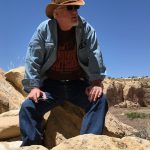Gary David has been intrigued by the Four Corners region of the United States for nearly twenty-five years. In 1994 he moved to Arizona and began an intensive study of the ancestral Pueblo People and their descendants the Hopi.
In late 2006, after more than a decade of independent research and investigation of archaeological ruins and rock art, his book The Orion Zone: Ancient Star Cities of the American Southwest was published by Adventures Unlimited Press.
The 2008 sequel is titled Eye of the Phoenix: Mysterious Visions and Secrets of the American Southwest. The third book in the series, The Kivas of Heaven: Ancient Hopi Starlore, was published in late 2010. These books are available from www.adventuresunlimitedpress.com or by calling toll-free 1 (815) 253-6390. Autographed copies of the books can be obtained from www.theorionzone.com.
Mr. David’s articles have appeared in Fate, World Explorer, UFO, Atlantis Rising, and Ancient American magazines, and in Graham Hancock’s anthology Lost Knowledge of the Ancients. Translations of Gary’s work have appeared in Erich von Däniken’s magazine Zagenhafte Zeiten and on the website www.antiguosastronautas.com. His writing was also featured on recent History Channel episodes of “Decoded” and “Ancient Aliens.” Gary continues to give lectures and international radio interviews.
What People Are Saying About His Work:
"Gary David's work is a treasure of enormous importance. He draws us deep into the mystery of Arizona and deeper still into the lost secrets of ancient cosmology. The truth behind the myths and symbols he's uncovering has the power to unify us, just as the Hopi prophesied." –
"The Orion Zone is an extensively researched study of archaeological evidence, historical accounts, and the oral traditions of the Hopi peoples of the American Southwest. Readers interested in astro-archaeology or in pre-Columbian America will find a great deal of thought-provoking material here, along with citations for further study." –
In his book Eye of the Phoenix, Gary David's "…analysis of Hopi cosmology is instructive. Noting their relationship with "Star People", coverage of the "Starchild" skull, UFOs and "Ant People" is thus part of the territory. Completing his discussion of the Hopi worldview, David looks at their prophecies about the progression of worlds and the signs leading to the next End Time in our era-signs that we'd be wise not to ignore. An atmospheric, inspiring book." –
"I have examined the Arizona-Orion ground-sky relationship, and I must say that I find this work intriguing. It is worth pursuing to the very end." –
"The correlation Mr. David makes between the Hopi and the Egyptian 'sky view' is most interesting." –
More articles
The Orion Zone: Ancient Star Cities of the American Southwest by Gary A. David, 17 February 2006
The Mothman of Pottery Mound by Gary A. David, 28 May 2009
Under the South African Sun
At the southern tip of Africa, equidistant from the Indian Ocean and the Atlantic, lies a high plateau known as the Great Karoo. This arid savannah aptly called the “thornveld” is dotted with camel thorn and umbrella trees. South of the fabled Kalahari Desert, the harsh region is still hot enough in summer for temperatures to reach well over 100 degrees Fahrenheit.
The late summer monsoon rains drawn from the Indian Ocean sometimes collect in saltpans spread across the barren plains—then quickly dry up. Rainfall in the northern part of the Great Karoo averages only about eight inches annually. Thunderstorms are violent but patchy, with ribbons of rain sometimes evaporating before reaching the ground—much like on the deserts of the American Southwest. However, the rainfall here was once sufficient to support a rich diversity of wildlife: giraffe, zebra, wildebeest, hartebeest, eland, springbok, buffalo, and ostrich. Along riparian areas rhino, hippo, and elephant roamed. Predator species included lion, leopard, hyena, and wild dog.
This unforgiving territory is the ancestral homeland of the San, sometimes known as Bushmen, and the Khoi, the latter formerly called the Hottentots. In fact, the word karoo is a San word that means “land of great thirst.”[1] The San were basically hunter-gatherers, whereas the later Khoi were pastoralists, herding sheep and cattle. The San and their famous click language were introduced to Western popular culture by the humorous movie “The Gods Must Be Crazy” and the more recent Disney film “A Far Off Place.”
On the distant horizon flat-topped hills (“koppies”) of sandstone and shale also resemble the mesas of my home territory in the southwestern U.S. Dark dolerite outcroppings strewn with of mineral-stained, igneous boulders were perfect for carving petroglyphs, or, as they call them in South Africa, rock engravings.
In September of 2009, I had the opportunity to travel there in order to assist my friend and colleague Rob Milne with his rock art research.[2] He and I along with his wife Slava visited a site called Driekopseiland, an Afrikaans name meaning “three hills island.” It is located on a working farm along the Riet River near the city of Kimberley in Northern Cape Province. Little did I expect to encounter images in stone that resembled the star beings carved by the ancient Hopi Indians of Arizona.
We arrived on the vernal equinox (September 22) at about 5:00 a.m., when Orion was just reaching its meridian. Getting out of the car to open the farm gates, I saw both Crux (the Southern Cross) and the brilliant Canopus for the first time in my life—the second brightest star in the night sky after Sirius. The San, by the way, consider Sirius to be the Grandmother of Canopus. A few rabbits and a steenbok (antelope) darted across the dirt road as we made our way to the site in the predawn chill. (Later in the day we saw a warthog dash across the road and a troop of mongooses scampering about and chattering. Surely a cobra must have been nearby.)
The Riet (“Reed”) River, a tributary of the mighty Orange River that flows into the Atlantic, is lined with non-indigenous eucalyptus trees and reeds over 15 feet high.[3] Driekopseiland contains over 3,500 engravings pecked or chiseled into a glaciated andesite “pavement” that parallels the river. The main part of this blue-gray slab is cut by natural fractures, thin and straight, that divide the horizontal rock expanse into various sections or panels. The whole area is at least 150 yards long and 75 yards wide.

View from a koppie near Kimberley in the northern Karoo.
Barely visible on the horizon is Platfontein, one of the final relocation settlements of the San.
A giant red anthill is seen in the foreground.
According to archaeologist David Morris, whom we later met at McGregor Museum in Kimberley and who autographed his new book for us (see Endnote 8.), over 90% of the petroglyphs are geometric, abstract, or nonrepresentational: grids, meanders, dots, hatches, zigzags, concentric circles, ovals, spirals, star shapes, sunbursts, nested figures, and calendar wheels. Every foot or so we came across some bewildering design deeply carved into a plane of stone so smooth it almost looked polished. Ranging in size from a few inches to a few feet, these perplexing petroglyphs were rarely superimposed—that is, one carved on top of the other.
We even found a great number of Celtic crosses, which are equilateral crosses inside circles. South African scholar Brenda Sullivan comments on their meaning:
“This symbol has many names. It has been called the five-fold bond, the tree of life enclosed within the circle of eternity, and more commonly, the Celtic cross. Well, the Celts may claim pride of name, but this most ancient symbol has been associated with the isangomas [medicine people] of Africa for millennia, and is still one of Africa’s most powerful signs of protection and communication with the Creator through the Shades.”[4]

Dawn along the Riet River, South Africa.
The dam (seen in the background) was built upstream from the petroglyphs in the 1920s.
On a panel downstream from the main section of the site, we also found petroglyphs that represented a number of animals: eland, elephant, rhino, baboon, anteater, and warthog. We encountered a few human-shaped engravings cut into the horizontal surface as well, which in some cases was as flat as a paved roadway.
Because rock art is difficult to date, the time frame of these images frozen in stone is anybody’s educated guess. Estimates range widely—from between the 10th millennium BC and the end of the first millennium AD.
Whenever the Driekopseiland glyphs were incised, they certainly took a long time to make. In other words, these labor-intensive markings were no idle doodling to wile away a hot afternoon. Andesite is a fairly hard mineral, and is rated 6 on the Mohs scale. Granite is a bit harder at 6.5 and quartz is only 7. Diamond is the hardest mineral and rates 10 on the scale.
Mined for thousands of years not far from here, the holy “Stones of the Sun” were most likely used to carve this hard rock. In 1866, these valuable gems were discovered downstream from the confluence of the Orange and Vaal Rivers, and hordes of miners flooded the area. Kimberley, of course, is now home to the world-famous De Beers corporation, whose “Big Hole” and museum Rob, Slava, and I later visited.
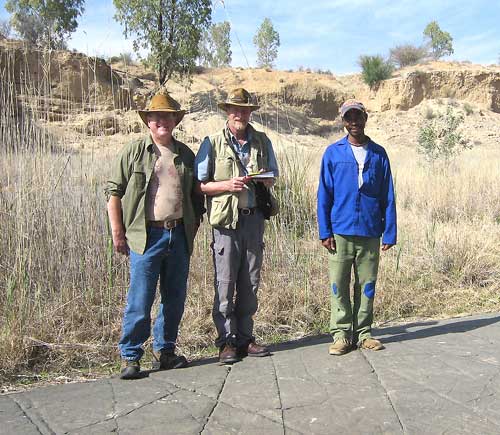
The author, Rob Milne, and San guide Adam. Photo © by Bronislava Milne.

Foreground: profile of creature with headdress framed by natural triangular fractures.

Celtic crosses (upper-left), sunburst, abstracts. Photo © by Bronislava Milne.
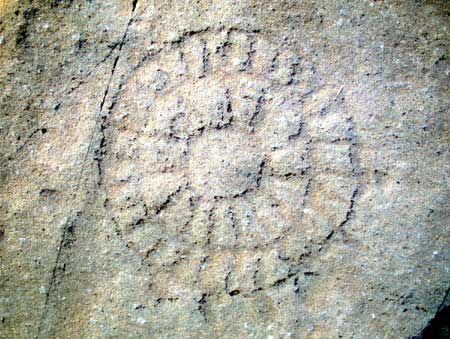
Lunar calendar:13 lines inside inner circle and 28 lines in outer circle.

Cupules forming space-capsule cone (?). Ingot shape (upper-left) is one of a group.

Geometric petroglyphs at Driekopseiland. Photo © by Bronislava Milne.
Aye, there’s the rub.
But what is the meaning of these enigmatic dream-symbols carved into the bedrock? David Lewis-Williams, cognitive archaeologist and specialist in South African rock art, says that these engravings were not merely representations of the natural world or abstractions of inner space rendered on static stone. Unlike the modern artist’s canvas, they were instead “windows on other worlds”— veils between the physical world and the spirit world. Like the interactive screens of a sacred video game, the petroglyphs were in fact “reservoirs of potency” that came alive the moment the San people trance-danced in front of them.[5]
Lewis-Williams is also the major proponent of the theory that the geometrics found at Driekopseiland were a depiction of the entoptics created by the optic nerve in the initial stages of an altered state. The shaman experienced these varied abstract shapes via intense drumming and dancing, sometimes in conjunction with hallucinogens. Just rub your eyes hard to get a mild sense of this phenomenon.
Even the academic Professor Morris admits to sacrosanct function of the engravings. “As a powerful portal between spiritual realms, a point of breakthrough perhaps second to none in the area, Driekopseiland would have been the kind of place where !Khwa was appeased, where protections were sought, so that ‘the rain comes down gently.’”[6]
Like the Pueblo people of the American Southwest, the San distinguish between (1) “male rain,” or lightning, fierce winds, and thunderstorms that pummel the earth, causing floods; and
(2) “female rain,” or gentle rains that slowly soak into the earth.[7] Morris believes that the ancient people who made these carvings conceptualized the river as the mythic Water Snake named !Khwa, a figure prominent in San mythology.
“The regular emergence and submergence of images from the waters of the Gama-!ab [San term for Riet River] seems to us a crucial element in the power of the engravings and, arguably, a key to their meaning. Like the body of a large beast living in the depths of the river, the rock surfaces appear to rise from one medium to another, glistening, striated and engraved. Using a related analogue, the artist Walter Battiss spoke of ‘great whales lying in the mud’ of Driekops Eiland, their backs ‘decorated with innumerable designs.’”[8]
Arching its engraved back, the giant Snake breaks the surface of the water—then plunges back into the stream. This vertical undulation has cosmological significance due to the fact that “to go under water” is a San trance metaphor for death or “to die.”
Likewise, the Hopi describe a subterranean water serpent known as Pálulukang, which lives in springs, waterholes, or rivers and controls thunderstorms and floods. Hopi cosmology also identifies the underworld with a pluvial afterlife where departed spirits reside.
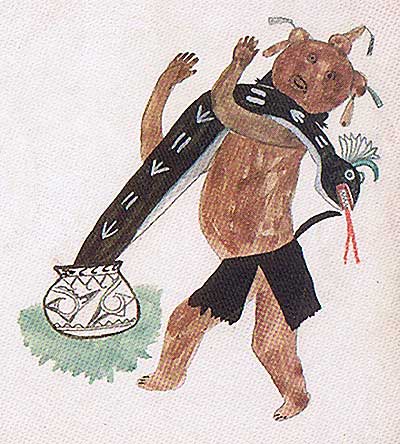
A Hopi drawing of a mudhead katsina (also spelled kachina, associated with the nether realm) wrestling with Pálulukang, the horned water serpent, which is akin to the Mesoamerican deity Quetzalcoatl.
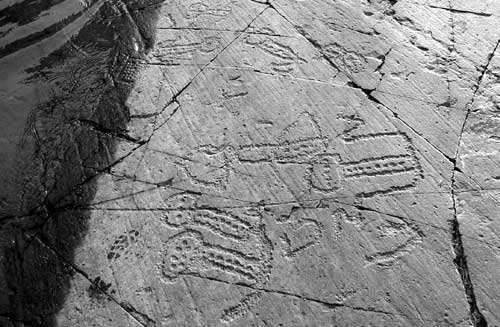
Phallic engravings with cupules next to river (dark area to the left).
The late epigrapher Barry Fell had interpreted some of the more abstract symbols at Driekopeiland as Libyan inscriptions written in Ogam script, one translation of which is as follows: “Under constant attack we have quit this place to occupy a safe stronghold.” Brenda Sullivan amplifies Fell’s rendition: “‘People suffering. A time of death and suffering. People were forced to abandon the place, and seek protection elsewhere’—either because they were attacked, or because of violent storms and flooding.”[9]
Although I am not psychic, as I sat in the midday sun at this site, a vague sense of malaise and subliminal tension pervaded the atmosphere. Even my South African friend Rob admitted he would not camp overnight here, due not to the dangerous wildlife but because of the evils spirits that potentially inhabit the place even today. Maybe we were simply experiencing, to quote the South African author Laurens van der Post, “…the ghosts of Africa which, as we all knew, walked not at midnight but noon.”[10]
Some of the most puzzling engravings that we found depicted humanoids with some sort of bizarre paraphernalia. What Rob has dubbed “the Spaceman” is located adjacent to “the flying saucer” and “the rocket.” The protrusion from this figure’s helmet is somewhat similar to the cone-shaped nose on a Hopi kachina, or spirit messenger.
The intimacy that many African tribes have with the celestial realm is presently confirmed by a world-renowned Zulu Sangoma (medicine man) and High Sanusi (“uplifter of the people”) whose name is Vusamazulu Credo Mutwa. Unlike most academics who seem to put up barriers between peoples and compartmentalize them for study, Baba Mutwa continuously shows us the enduring but dynamic connections between continents. For instance, he sees direct parallels between Native American and African tribes.
“There is not a single nation among Native American peoples whom I visited in my journeys to the United States that does not have cultural and linguistic links with Africa. Among the Hopi Indians of the American Southwest, I found a custom where masked people, who are called Kachinas, come at certain times during the year and conduct sacred ceremonies and bless the people. In the African country known as Zambia, there is a group of people who practice what is called Mackishee. People wearing elaborate masks, which refer to certain spirits, visit villages at times and listen to confessions of the villager’s sins. These ‘spirits’ bless the people for the coming period of time and go on their way again.”[11]
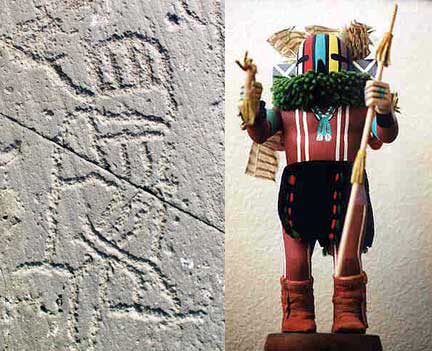
LEFT: Anthropoid with staff and striped helmet, Driekopseiland, South Africa.
RIGHT: Hopi Corn Kachina doll, Kriss Collection, Museum of Northern Arizona.

LEFT: Petroglyph of flying saucer ascending (?).
RIGHT: Petroglyph of cone-shaped rocket (?).
Credo Mutwa claims that creatures from a star in Orion once lived in pre-human times on the Earth and built a huge subterranean metropolis in the heart of Africa.
“Before human beings were created on this planet, there had existed a very wise race of people known as the Imanyukela. These people had come from the constellation known to white people as Orion, and they had inhabited our earth for thousands and thousands of years. And that before they had left our earth to return once more to the sacred Spider constellation, they made a great evacuation under the earth, beneath the Ruwensory [Rwenzori] Mountains—the Mountains of the Moon. And deep in the bowels of Mother Earth, the Imanyukela built a city of copper buildings. A city with a wall of silver all around it. A city built at the huge mountain of pure crystal. The mountain of knowledge. The mountain from which all knowledge on earth comes. And a mountain to which all knowledge on earth ultimately returns.”[12]
The Hopi also have a female spider figure named Kokyangwuhti, who usually assists people in their quests and was present during the origin of humankind. The Hopi, incidentally, acknowledge four races of people. Spider Grandmother gathered four colors of mud –black, white, yellow, and red– and mixed them with her saliva in order to create these four races, each with its own basic language. Humans were, by the way, created in the image of the sky god Sótuknang. In addition, the Hopi have many legends of what they call “flying shields.”

Hopi drawing of their sky god Sótuknang. Because of his control of lightning, he is associated with Pálulukang.
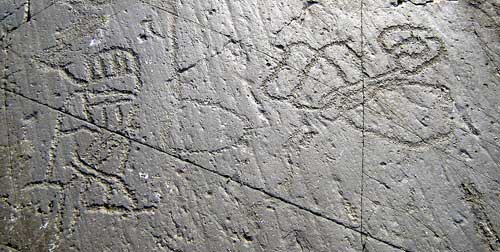
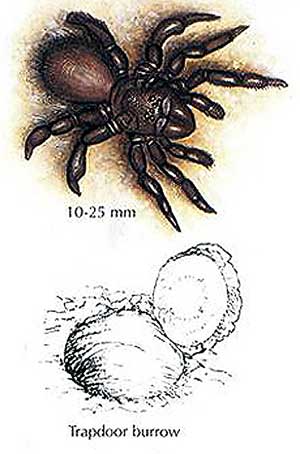
Driekopseiland “Spaceman” engraving next to trapdoor spider and burrow (above). Rob Milne believes that the depiction of the eight legs would be superfluous, because the spider is stationary. The trapdoor spider is a nocturnal insect. Credo Mutwa claims that Orion is the Spider constellation.
One petroglyph that Rob showed me ostensibly looked like a sun symbol, with rays emanating from the circle. Then I flashed on another icon of a very different sort and thought, “no, that can’t be it,” and put it in the back of my mind.

Later I got a picture of NASA’s Pioneer Plaque and compared it with the engraving with a radial pattern. (Photo is rotated so the natural rock fracture bisecting the circle is horizontal.) There are seven rays in each hemisphere of the circle, corresponding to the pulsars (see diagram below). At the upper-right is a circle that contains two lines, corresponding to the hydrogen molecule on the plaque. The outer circle may contain 33 rays, but it is impossible to tell because the rock surface is flaked to the immediate right of the circle.
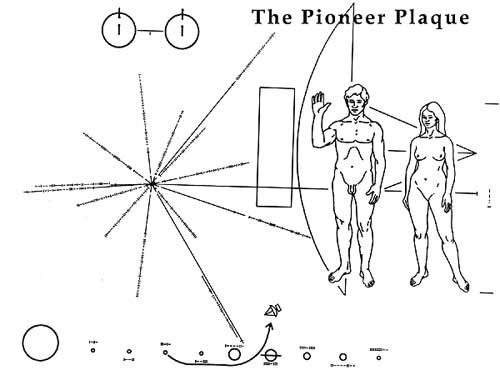
The 6” X 9” gold-anodized aluminum plaque (above) shows the position of the sun with respect to the center of the galaxy and nearby pulsars. Carl Sagan and Frank Drake created it in an attempt to communicate with extraterrestrial life somewhere in the far reaches of outer space. Launched in 1972, the Pioneer 10 and the Pioneer 11 were the first spacecraft designed to leave the solar system, and both carry duplicates of the plaque. It displays the then-nine planets, including Pluto, which, by the way, was discovered at Lowell Observatory in Arizona. It also shows the Pioneer spacecraft’s planet of origin, its trajectory past Mars and Jupiter, and its slingshot past Saturn outward from our helio-heart. The radial pattern consists of 14 lines made up of long binary numbers that represent the periods of the pulsars. The horizontal line that extends past the humans represents the Sun’s relative distance to the center of the galaxy. A silhouette of the spacecraft in scale is juxtaposed to the humans so that relative size can be determined. The two circles at the top represent the fundamental state of the hydrogen atom, which acts as a universal clock. The regular decrease in the frequency of the pulsars will enable ETs to determine the time elapsed since each spacecraft was launched. In about 2 million years the plaque should arrive at Aldebaran, 68 light-years away. Let’s hope that whatever intelligence retrieving this message in a bottle is not reading an elegy to an extinct civilization.
Did the people who made this South African rock engraving perhaps thousands of years ago actually “remote view” the future and glimpse this image we created in the late 20th century, which is now bound for the stars? Were they in contact with an intelligence that knew about the Pioneer Plaque from their journeys through space-time and wanted to convey its significance to indigenous tribes? Or is this all just a big “coincidence”?
Countless hours were spent carving sacred symbols into obdurate stone. These inner visions of the spirit world had been received from both cathartic trance states and quiescent deep meditation. The veil between the physical and non-physical universes was extremely thin, and in many cases the interaction between the two occurred right at the rock surface, which appeared as a translucent and permeable membrane.
Beyond the two worlds merging like dual circles of the vesica piscis are myriad realities, world upon world. Some of these are stars with revolving planets inhabited by entities whose technologies may be millions of years ahead of ours. Others worlds are purely inter-dimensional, with completely different laws of physics and ontological paradigms. As postmodernists thousands of years removed from San sensibilities, we must in the end admit that we are nothing but Horatios confronting this “wondrous strange.” At the end of the 19th century, one San informant reported: “We do not utter a star man’s name.”[13]
Copyright © 2011 by Gary A. David. All rights reserved.
Website: www.theorionzone.com
Email: [email protected]
Endnotes
- Diffusionist archaeologist Dr Cyril A, Hromník, who was born in Slovokia, educated at Syacuse University, and lives in Cape Town, South Africa, claims that the word karu is actually a Tamil term (Dravidian of southern India) meaning “arid country.” Maré Mouton, “‘South Africa is denied its rich cultural history’,” Village Life, No. 15, December 2005-January 2006, p. 21. Hromník further believes that the Khoi (Hottentots), whom he calls the Quena, are descendants of Indian fathers and South African San mothers. “Were Indians the first colonists in SA?”, Electronic Mail & Guardian, October 7, 1997,
http://cosmologicaljourneys.com/pdf/Chariot%20for%20cj.pdf. [back to text] - See Rob Milne’s excellent book titled Anecdotes of the Anglo-Boer War (Johannesburg, South Africa: Covos Day Books, 2000). For photos and explanations of South African rock art, see his website: http://www.robmilne.com. Also, read his description of an Orion Correlation/engraving site near Lydenburg in Mpumalanga (“rising sun”) Province of South Africa, which was published in Appendix 1, Gary A. David, Eye of the Phoenix (Adventures Unlimited Press, 2008). Rob’s comprehensive book on South African archaeoastronomy titled Beyond Orion is forthcoming.[back to text]
- As I wrote in my book Eye of the Phoenix, the reed is a universal symbol of civilization, high culture, education, writing, and even celestial significance. For instance, the Hopi refer to the Milky Way by the term songwuka, literally “big reed.” They have a legend of coming up through a great reed from the previous Third World to the present Fourth World. This perhaps suggests an interstellar journey along the galactic axis.[back to text]
- Brenda Sullivan, Spirit of the Rocks (Cape Town/Pretoria/Johannesburg, South Africa: Human & Rousseau, 1995), p. 13. For information on the Celtic cross as ancient navigational instrument and architectural tool, see Crichton E M Miller’s excellent book The Golden Thread of Time (Rugby, Warwickshire, UK: Pendulum Publishing, 2001),
http://www.crichtonmiller.com. [back to text]
- David Lewis-Williams and Geoffrey Blundell, Fragile Heritage: A Rock Art Fieldguide (Johannesburg, South Africa: Witwatersrand University Press, 1998), pp. 24-25.
—The trance dance is a curing ritual whereby spirits are contacted. Resembling the Native American Ghost Dance of the late 19th century, it is performed by dancing in a ring, using hyperventilation in order to create a state of transcendent exhaustion. “The !Kung [San] medicine man gradually works himself up into a state of trembling and sweating. When he approaches trance, he feels a rising sensation which he ascribes to the ‘boiling’ of his medicine (n/om); as he enters deep trance, he falls to the ground, sometimes executing a somersault.” J. David Lewis-Williams, A Cosmos In Stone: Interpreting Religion and Society Through Rock Art (Walnut Creek, California: Altamira Press, 2002), p. 59.[back to text] - David Morris, “Introducing a new interpretation of Driekopseiland,”
http://www.driekopseiland.itgo.com/about.html[back to text] - Lewis-Williams and Blundell, Fragile Heritage, op. cit., p. 21.[back to text]
- John Parkington, David Morris, and Neil Rusch, Karoo Rock Engravings: Marking Places in the Landscape (Cape Town, South Africa: Southern Cross Ventures, August 2008), p. 78.
—The San used to call out to the mythical Water Snake: “Your breast gurgles because it is full of water. The Stars love you—therefore the gemstone gleams on your head.” Was this gemstone a diamond? “/Xam [San] astronomical references in G R von Wielligh’s Boesman-Stories,”
http://www.psychohistorian.org/astronomy.[back to text]
- Barry Fell, “Ogam Inscriptions from North and South Africa,” and Brenda (Sullivan) Wintgen, Ph.D., “Ntethological Analysis of Ogam Script from Driekopseiland Translated and Published by Professor Barry Fell,” both articles from The Epigraphic Society Occasional Publications, Vol. 6, No. 116, 1979. Brenda Sullivan: “In 1978 I met with Professor Barry Fell, founder of the Epigraphic Society, in Boston, USA. In 1998, I heard of the Mashigo Institute for the Interpretation of Symbols, and became so caught up in this new knowledge that I went on to obtain a Masters degree. By combining my years of self-study and research with the methodology of the advanced courses of Ntethology and Mashigology, I was awarded my Ph.D. for my interpretation of the symbolism of 30 South African rock engravings – a first in this field.” http://www.africanenigmas.co.za/about_us.html[back to text]
- Laurens van der Post, The Lost World of the Kalahari (Middlesex, England: Penguin Books, 1968, 1958), p. 37.[back to text]
- Vusamazulu Credo Mutwa, Zulu Shaman: Dreams, Prophecies, and Mysteries, edited by Stephen Larsen, original title Song of the Stars (Rochester, Vermont: Destiny Books, 2003, 1996), p. 157.[back to text]
- “Vusa’mazulu Credo Mutwa—Biography 03: Mysteries of Africa,”
http://credomutwa.com/about/biography-03[back to text]
- “Story: We do not utter a star man’s name,” Lucy Lloyd |xam Notebooks, December 1878, The Digital Bleek & Lloyd, http://lloydbleekcollection.cs.uct.ac.za/data/stories/826/index.html[back to text]





